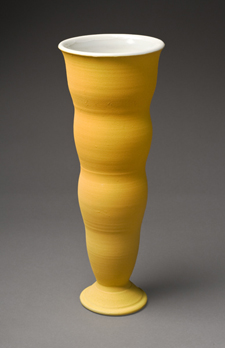
Roethke wrote: “Art is the means we have of undoing the damage of haste. It’s what everything else isn’t.” I am a Slow Artist. My career has been a long-range project, and I have been fortunate to carry out my professional life with a great deal of creative latitude. The freedom to work and study broadly has led me to unexpected discoveries, pleasures, and inspirations.
I have always had an interest in the natural world and the forces that animate it, and my first experiences as a young artist in Rome on a Fulbright, in the mid-1980s, fostered a powerful new interest in the products of human endeavor. In Italy I developed a deep appreciation of the wealth of ceramic history and its linkage to architecture. I found rich opportunities to ground my interests in a larger historical and cultural base, and to learn more about the relationships, both technical and aesthetic, between sculpture and functional ceramics and their patronage. Etruscan fictile works and Baroque sculpture—in particular Guido Mazzoni and Niccolo dell’Arca’s full-scale terra cotta Lamentation groupings—activated a new respect for the didactic role of our ceramic past and what it might offer us in the present. Since that first year there, Italy has been an aesthetic and intellectual force in my work, and whenever I return I find new inspirations in its physicality, context, grace, language, civility and style. Italy’s sculptural legacies renew my awareness of the sculptural object’s power to mediate between the corporeal and emotional selves, to integrate intuitive and sensory experiences, and to locate and transform the viewer in time and space.
I am greatly stimulated by contact with other visual and media artists, sound artists, composers, musicians and poets, and I look forward to new projects of inquiry that examine the tenets of what we call “progress.” Using figure, architecture, concept and text in conjunction with innovative and traditional ceramics techniques, my mission is to make vessels and sculptural forms that challenge conventions, reveal unseen worlds, and displace boundaries in ceramic art.
My studio practice has often focused upon the exploration, examination, confrontation, and refutation of classical forms, examining the underpinnings of aesthetic consensus. I am especially interested in the icons of modernity and their underlying politics, how “things” convey “meaning,” and how beauty connotes value. I have developed narrative ceramics in porcelain and white stoneware, using texts and references to the body as a vessel, and using the vessel as a metaphor for the body. In exhibiting my work and participating in a variety of international venues and residencies, I seek a connection to my audience through an articulation of voluptuousness, the fusion of form and surface, and a thoughtful and sustained consideration for what is aesthetically compelling. My research, while ranging widely from studies of contemporary and historical architectural ceramics in Italy to the emergence of women artists in western Japan and the translation of microscopic pollen form into ceramic sculpture, has been an extension of my work and of my desire to connect to the work of artists in other times and cultures. I have written and published articles in professional journals addressing matters of patronage, history, theory and criticism within the field of ceramics.
My exhibition record reveals the powerful influence of Italian architecture and sculpture upon my studio work. I regularly return to “corporeal” themes and “real time” in a search to seek out and reclaim tactility in our increasingly mediated world. In “Flesh and Bone,” I addressed subjects related to war and domesticity, examining the impact of industrial-scale warfare upon the body and the body politic, and the ways that military and domestic lives create their own chronologies in debris. Always concerned with the tensions expressed between the ideal of integrity—social, ethical, physical, and aesthetic—and the forces that undermine it, I have also worked with figurative ideals in the vessel, and its role as a metaphor for human beauty. In that exhibition and many others, including “Oneiric Artifacts,” I returned to building sculptures by hand, and to the vibrant palette of industrially sourced ceramic pigments I first employed in the early 1970s, but now applied in multiple semi-transparent layers to achieve a density, vitality and complexity in color over several firings. This technique has enabled a highly complex marriage between surfaces and form, which I have continued to refine in my research and practice. My interest in pollen has intensified as a result of previous research in electron microscopy and its role in understanding the neuroceptors that create human pain response. In studying, imagining, and making pollen forms, I have developed a profound appreciation of the role of electron microscopy in revealing the natural world. Most recently, travel to Tanzania and Zanzibar has offered the opportunity to see the wildlife of Southeastern Africa in its natural habitat, to witness the delicate balance among the creatures of that environment, and to ponder the impact of the Anthropocene upon them.
— Susan Crowell
© 2021 Susan Crowell
Site Design by Catherine Meier
